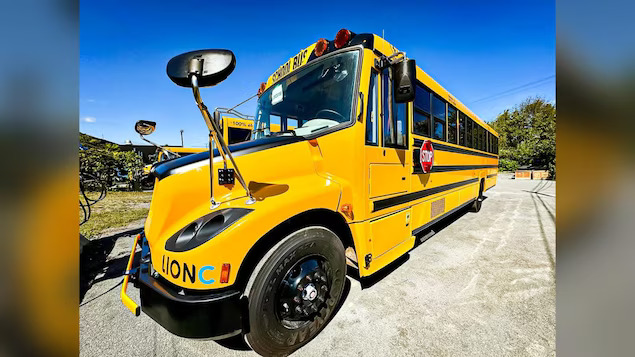Canada News
Why doesn’t Canada have more electric school buses?
By Janyce McGregor, CBC News, RCI

Lion Electric in Saint-Jérôme, Que. is the only Canadian school bus manufacturer that focuses exclusively on electric models. (Toni Choueiri/CBC) Photo: (Toni Choueiri/CBC)
3 years in, the federal zero emission transit fund hasn’t done much to electrify school fleets
For anyone who spent their childhood riding stinky, noisy school buses, it’s a revelation to climb aboard one of the electric models coming off the assembly line at Lion Electric in Saint-Jérôme, Que., northwest of Montreal.
The only thing you hear is the wheels on the road,
said founder and CEO Marc Bédard.
Proponents believe kids who ride e-buses show up calmer and more focused for school. U.S. data linking test scores to diesel fumes (new window) backs them up. But so far, only about two per cent of Canadian school buses offer students this advantage.
Bédard and his team are motivated to deliver technology that helps kids — not to mention the planet they’re increasingly anxious about inheriting. But like many green entrepreneurs, he’s faced challenges. Bédard lays one of his current problems at the feet of the federal government.
There’s nothing worse than announcing a program and not deploying it,
he said, adding he’s frustrated by the slow pace of the federal approval process for the Zero Emission Transit Fund (ZETF).
This $2.75-billion fund was one of then-infrastructure minister Catherine McKenna’s final announcements before the 2021 election. Alongside the $1.67 billion available in loan financing from the Canada Infrastructure Bank, bus operators were supposed to be able to offset the high startup costs of transitioning to an electric fleet.
E-school buses are cheaper to operate and can pay for themselves over the long run. But their initial price tag is double what diesel replacements cost. The short-term contracts of private service providers, which supply most of the bus service across Canada, don’t always provide incentives for longer-term change without government subsidies.
Federal delays contributed to layoffs: CEO
Based on the government’s objectives for this fund, Bédard budgeted for Lion — the only manufacturer that makes exclusively electric models — to deliver about 500 buses a year for the duration of the five-year program.
In fact, his first order to be approved (new window) for federal financing (new window) took about two and a half years. Two hundred e-buses were finally greenlit in June (new window) for Langs Bus Lines in southwestern Ontario.
This gap between what Lion had ramped up to deliver and the slower pace of federal approvals hit the company’s finances hard. Bédard said he was forced to lay off 700 employees earlier this year.
We’re behind. That’s a shame,
the CEO said, adding his employees would love to come back and help Canada catch up to school districts in the U.S. that have received more timely government support.
We have over 1,000 units in our order book. We have a lot of operators that want to electrify their fleet right now and today they are [still] waiting for an approval.
Several dozen buses were rolling out when CBC News visited the Lion Electric facility. Some with white roofs and English lettering were destined for American school districts. Others with distinctive blue bumpers will soon carry Quebec students.
Both federal and provincial politicians have visited Lion Electric’s facilities several times, touting its batteries, trucks and buses to showcase government climate initiatives.
Quebec Premier François Legault’s government has done more to walk the walk than any other provincial jurisdiction. Quebec now has a mandate to replace school bus fleets only with locally-sourced electric buses from now on, and provincial rebates cover about half the cost of each new bus.
The Canadian Electric School Bus Alliance — a coalition of environmental advocates pushing for an all-electric school fleet by 2040 — estimates that of the roughly 1,200 electric school buses taking Canadian kids to school this fall, about 1,000 are in Quebec.
Canada’s most common bus
There are more school buses on Canadian roads than any other type. At current pricing, you can replace three diesel school buses for the cost of one emissions-free public transit bus — so focusing federal funding on school buses would deliver more emissions-cutting bang for the buck.
School buses are also ideal for electrification. They have predictable local routes each day, and return to consistent parking locations off-hours for predictable and affordable re-charging. (Lion’s batteries can also store and return power to the grid to help meet peak or emergency demand, especially in remote locations.)
Nevertheless, only two per cent of the 51,000 vehicles in Canada’s school bus fleet are electric at the moment. To reach the Alliance’s objective of weaning that fleet off diesel by 2040, bus operators would have to procure more than 2,800 green vehicles per year. They’re nowhere near that pace.
And some operators are still buying new diesel buses because that’s all they can afford. Based on current lifespans, those polluters will still be emitting on Canada’s roads 15 years from now.
Prince Edward Island faced that dilemma this summer. That small provincial government administers its own student busing and was an early adopter of e-buses. There were growing pains (new window). But P.E.I. applied for federal funding to buy 207 more e-buses to keep scaling up.
That approval hasn’t come. In the meantime, older diesel buses break down. Faced with not having enough vehicles, the province reversed gears and bought 30 diesel replacements while awaiting word on federal assistance.
I think if you look across Canada, you’ll see all kinds of jurisdictions that are planning to switch to electric buses that are kind of in limbo while they wait for this funding,
said Steven Myers, P.E.I.’s minister of environment, energy and climate action.
Many needs, shrinking fund
The Zero Emission Transit Fund wasn’t set up exclusively to electrify school transportation. From its outset, federal officials said the money was intended to help purchase 5,000 public transit or school buses over five years. At the moment, the fund’s swamped with applications from cities that can’t afford to green their transit systems without help.
The ZETF also took a haircut last year — trimmed to $2.4 billion as part of the government’s push to cut spending across departments.
Federal Infrastructure Minister Sean Fraser has said more school bus announcements are coming. But he’s also hinted that school bus operators are competing with municipalities. So jurisdictional politics may be afoot, with federal and provincial governments passing this potato around.
Keep in mind we traditionally don’t, in federal politics, develop programs designed for provincial education systems, but more often have developed programs to respond to applications by municipalities to improve transit more broadly,
the minister told CBC News during a conference in Ottawa for Ontario municipalities.
If you think about it, school buses are transit. They’re public transit for our kids,
said Miriam Ponette, a public policy researcher with Green Communities Canada, one of the coordinators of the Canadian Electric School Bus Alliance.
Ponette said she questions whether the benefits of electrification are rolling out equitably, particularly given the fact that kids have very long rides on diesel buses — far longer than many adults sit on public transit.
Communities that … have suffered already from environmental pollution should be prioritized and getting the cleaner buses,
she said. “We have to be thinking about Indigenous communities and rural communities who may have different challenges in accessing funding.
“Diesel fumes are a known carcinogen. Something that was very surprising to me is that there are more diesel fumes inside the bus than outside the bus.
Children have a lot of climate anxiety. By transitioning to electric school buses first, we’re helping with kids mental health. They can see this important part of their lives as being part of the change.
This article is republished from RCI.





















